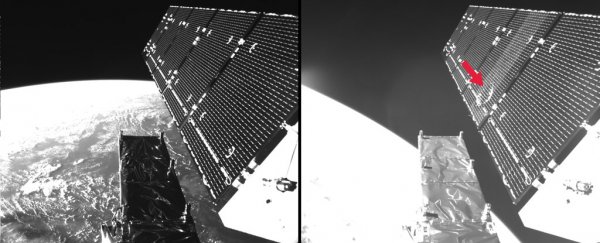A tiny particle travelling at an estimated speed of more than 40,000 kilometres per hour (24,850 mph) has collided with a satellite in orbit, the European Space Agency (ESA) has revealed.
The incident, which occurred last week, involved what ESA scientists think was a small object measuring only a few millimetres in width – but the shock of the collision still managed to create an impact area on the satellite's solar array measuring some 40 centimetres (15.7 inches) across.
"Such hits, caused by particles of millimetre size, are not unexpected," says ESA space debris chief Holger Krag. "These very small objects are not trackable from the ground, because only objects greater than about 5 cm [2 inches] can usually be tracked and, thus, avoided by manoeuvring the satellites."
ESA engineers twigged to the incident when they observed a sudden small power reduction in the solar array of Copernicus Sentinel–1A – a radar imaging satellite launched in 2014 for the purpose of monitoring environmental changes from orbit.
In sync with the power reduction, the team noticed a slight change in the Sentinel–1A's orientation and orbit, which suggested a possible collision between the satellite's solar-array wings (seen in the image above) and a piece of human-made space debris or micrometeoroid – a tiny meteoroid weighing 1 gram or less.
While nobody knows what the particle was, the ESA suspects it was a piece of space junk, as micrometeoroids of extraterrestrial origin are less common than human-made debris at the Sentinel–1A's orbital altitude of 700 kilometres (435 miles).
To help them figure out what might have happened, the engineers activated cameras onboard the satellite that hadn't been used since its launch in 2014. These cameras, positioned to monitor the Sentinel–1A's solar arrays, confirmed the collision hypothesis.
"In this case, assuming the change in attitude and the orbit of the satellite at impact, the typical speed of such a fragment, plus additional parameters, our first estimates indicate that the size of the particle was of a few millimetres," says Krag.
"The pictures of the affected area show a diameter of roughly 40 cm created on the solar array structure, confirming an impact from the back side, as suggested by the satellite's attitude rate readings."
Depending on which way you look at it, Sentinel–1A was either very lucky or very unlucky for this space collision to have happened the way it did.
Obviously it's unlucky to have any kind of run-in with a rogue space particle travelling at these speeds. As Krag explained to Victoria Turk at Motherboard, the chances of a satellite being hit in its lifetime by a particle of this size are somewhere between one in 30 and one in 130.
So Sentinel–1A definitely drew the short straw on that front. But on the other hand, NASA says there are more than 500,000 pieces of larger space junk currently being tracked in orbit – and millions of smaller projectiles that we don't know about and can't monitor – so the satellite got off lucky here, given it sustained no serious damage in the prang.
The ESA says the impact will have no effect on the satellite's routine operations, and despite the dip in power generation from the damaged solar array, the Sentinel–1A still has a surplus of electricity to do its day job, like measuring how the Himalayas shrank after the 2015 Nepalese earthquake.
So while there's no way of knowing for sure what this particle was, if it was a piece of space junk left over from previous human space exploration, it's a testament to how dangerous this kind of debris can be.
That means we should do everything we can to avoid leaving more junk behind in space, to head off things like satellite collisions, and even potential armed conflicts resulting from misinterpreted accidents in space.
"These kind of [debris management] measures we have to do – everybody has to do it in space," Krag told Motherboard, "so that we keep space fit for spaceflight in future."
